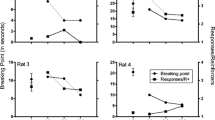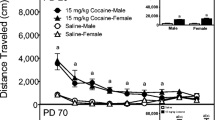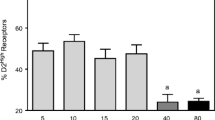Abstract
The dose-response relationships for three stimulants have been explored. These drugs have been shown to differ in potency and, with successive doubling of doses, have been found to have dose-response curves of differing slopes. In addition, the relationship between dose and activity level was not the same for younger and older rats. The relationship between dosage of both d-amphetamine and methylphenidate and locomotor activity was not the same in the light and the dark. The latter finding suggests a difference between these two stimulants and the third stimulant studied, caffeine, whose effects where unaltered by ambient illumination level.
Similar content being viewed by others
References
Adler, M.: Changes in sensitivity to amphetamine in rats with chronic brain lesions. J. Pharmacol. exp. Ther. 134, 214–221,(1961)
Alexander, M., Isaac, W.: Effect of illumination and d-amphetamine on the activity of the rhesus macaque. Psychol. Rep. 16, 311–315 (1965)
Cole, J.: The amphetamines in child psychiatry: a review. Sem. Psychiatr. 1, 174–178 (1969)
Edwards, A. L.: Experimental design in psychological research. New York: Rinehart 1960
Fischer, K., Wilson, W.: Methylphenidate and the hyperkinetic state. Dis. nerv. Syst. 32, 695–698 (1971)
Isaac, W.: A study of the relationship between the visual system and the effects of d-amphetamine. Physiol. Behav. 6, 157–159 (1971)
Isaac, W., Stinnette, M.: The effects of d-amphetamine, caffeine and illumination on fixed interval performance in the squirrel monkey. (Paper presented at Southeastern Psychological Association, 1973)
Isaac, W., Troelstrup, R.: Opposite effect of illumination and d-amphetamine upon activity in the squirrel monkey (Saimiri) and owl monkey (Aotes). Psychopharmacologia (Berl.) 15, 260–264 (1969)
Knights, R., Hinton, G.: The effects of methylphenidate on the motor skills and behavior of children with learning problems. J. nerv. ment. Dis. 148, 643–635 (1969)
Mabry, P. D., Campbell, B. A.: Ontogeny of serotonic inhibition of behavioral arousal in the rat. J. comp. physiol. Psychol. 86, 193–201 (1974)
Ritchie, J.: Central nervous system stimulants II. The xanthines. In: The pharmacological basis of therapeutics. Goodman, L., Gilman, A., eds. New York: Macmillan Comp. 1965
Seegal, R., Isaac, W.: Sensory influences upon amphetamine tolerance. Physiol. Behav. 7, 877–879 (1971)
Stein, L., Weiss, C.: Behavioral phermacology of central stimulants. In: Principles of psychopharmacology, Clark, W., del Guidice, J., eds., pp. 313–326. New York: Academic Press 1970
Werry, J., Sprague, R.: Hyperactivity. In: Symptoms of psychopathology, Costello, C., ed., pp. 397–417. New York: Wiley 1970
Author information
Authors and Affiliations
Additional information
This work was supported by research grant (MH 22140) from the National Institute of Mental Health.
Rights and permissions
About this article
Cite this article
Kallman, W.M., Isaac, W. The effects of age and illumination on the dose-response curves for three stimulants. Psychopharmacologia 40, 313–318 (1975). https://doi.org/10.1007/BF00421469
Received:
Issue Date:
DOI: https://doi.org/10.1007/BF00421469




